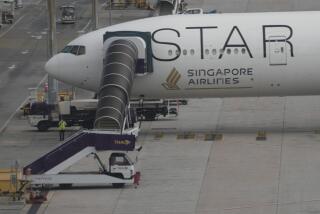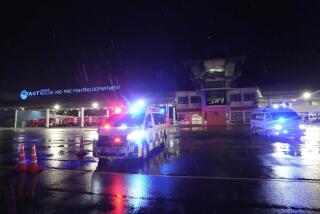Flying Doctors Extend Lifeline of Modern Medicine to Primitive Places
HO CHI MINH CITY, Vietnam â For four days after breaking her hip on a cruise, an 84-year-old Canadian woman lay on her cabin bed while her husband doled out painkillers and the shipâs surgeon checked in between cases of seasickness and sunburn.
When the liner finally docked at Ho Chi Minh City, there were two choices: an operation at the infection-prone local hospital or evacuation to a first-class facility in Bangkok, Thailand.
Send in the flying doctors.
A company called AEA International chartered a plane and flew a team headed by Dr. Kanwar Singh, its senior medical advisor in Bangkok, to the former Saigon for a nighttime evacuation.
The plane was greeted on the tarmac by two ambulances, one bearing the woman, the other a Filipino crewman with appendicitis.
The patients were carried on stretchers into the plane and strapped down. Battery-powered heart and oxygen monitors and intravenous drips hanging from the luggage racks ensured they made it to Bangkok and the operating room in good shape.
âVietnamese hospitals are technically very skilled,â said Dr. Philippe Barrault, an AEA physician, but the hospitals are not up to world hygienic standards. âWe couldnât recommend them.â
The bill for the evacuation came to nearly $30,000, but the cruise line paid $25,000 of it.
Such flights are becoming increasingly common as tourists visit exotic locales and business people roam Third World countries looking for new deals. The demand has spawned a booming trade for medical-assistance companies.
âThere are more and more people traveling,â said Nicholas Lance, director of business development for the Washington-based U.S. Assist. âThe world is changing. Travel patterns are changing. People are going to less developed countries. Thereâs always risk.â
The industry was born in France in 1963 with the founding of Europ Assistance, which served Europeans who were increasingly traveling outside national borders as the Continent emerged from the traumas of World War II.
Most of the big companies are still based in Europe, but they have far-flung empires of subsidiaries, clinics and alarm centers. Among them are Europ Assistance, Mondial Assistance, International SOS Assistance and SFA, which owns U.S. Assist.
AEA, formerly known as Asia Emergency Assistance, was founded in Singapore by French doctors in 1981--just in time to cash in on the economic boom in Asia. It, too, is expanding to other continents.
The companies are tight-lipped about earnings, but Peter Lindner, general manager for AEA in Bangkok, says the company experienced 30% growth in 1996, and revenue is expected to reach $100 million this year.
No international regulatory body oversees the companies to set standards or prices. They do business by reputation, marketing their services directly to individuals and corporations or via insurance and credit-card companies. In Europe and the United States, many travel-insurance policies include a medical-evacuation provision.
Multinational companies with staff stationed around the world find such coverage essential. Boeing Corp. has contracts with AEA to care for its staff in Asia and with U.S. Assist for its employees in Europe.
âWe have 350 employees outside the United States,â said Peter Conte, a Boeing spokesman. âWe donât use these services every day, day in and day out. But itâs been used often enough that itâs invaluable.â
Assistance can range from calling a doctor for advice on stopping diarrhea to arranging a full-blown air evacuation.
When an Air Senegal plane crashed at a remote African locale in February, Europ Assistance and other companies turned an Airbus A300 into a flying hospital to fly many of the 29 injured to Europe.
Some companies offer nonmedical help for everything from tracing a stolen car to finding theater tickets. SOS uses former intelligence operatives to evacuate clients from countries when the political situation turns dangerous --as in Algeria, where foreigners became the targets of Islamic extremists.
Others prepare comprehensive first-aid kits that journalists have carried into the war-and-refugee anarchy of Zaire, where hospitals have no medicines and staying alive means giving a local doctor the tools to do the job.
Evacuation is a complex job. Landing permits need to be arranged. The company must decide what transportation to use--an ambulance or an airplane, a commercial flight or a chartered plane.
âIt may sound simple, like a doctor just jumping in a plane and flying away,â Lindner said. âBut thereâs a lot of logistics going on.â
The hardest decisions are made on the ground.
Singh, the AEA physician in Bangkok, recalls retrieving a Briton suffering psychiatric problems at a Thai resort. Armed with a sketchy patient history, he traveled there and found her chained to a hospital bed.
The woman said she had been having a bad vacation and was frustrated by her inability to communicate. Believing her to be merely an unhappy traveler, Singh booked tickets for an airline flight to Bangkok.
In mid-flight, the woman stripped naked in the bathroom, ran through the cabin and hurled herself at the emergency exit. As she struggled to open it, passengers screamed and strapped on their seat belts, terrified that they would be sucked out of the plane.
The cabin crew subdued the woman, and a shaken Singh administered a sedative. Medical records obtained later showed the woman had had previous psychological problems and wished to commit suicide.
âIâd never have taken her onto that plane if Iâd known,â Singh said. âBut it wasnât as bad as it sounds. Most people donât know the emergency doors are controlled from the cockpit.â
More to Read
Sign up for The Wild
Weâll help you find the best places to hike, bike and run, as well as the perfect silent spots for meditation and yoga.
You may occasionally receive promotional content from the Los Angeles Times.






